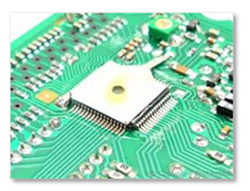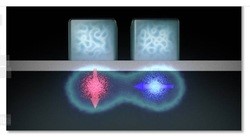October 8, 2015 by Steve Murray
Quantum Computing Just Got Real

Quantum computing just took a big step forward, as engineers at the University of New South Wales (UNSW), in Sydney, successfully fabricated a quantum logic gate in silicon for the first time. The achievement represents the last physical component needed to realize silicon quantum computers, which utilize the behavior of subatomic particles to solve problems beyond the capabilities of today’s supercomputers.
“What we have is a game changer,” said team leader Andrew Dzurak, Scientia Professor and Director of the Australian National Fabrication Facility at UNSW.
It looks like he may be right.
Calculating with qubits
Conventional computers operate on binary data bits, represented by the states of its transistors. Each bit has a value of either 0 or 1, which means that logical operations must be done sequentially – although at very high speeds – as transistors change their values.
Quantum computers operate on quantum bits, or qubits. Qubits can represent both 0 and 1 at the same time, a principle known as superposition. This feature allows the computer to perform several logical operations in parallel. A two-qubit system, for example, can operate on four values at once, a three-qubit system can operate on eight values, and so on. Quantum computing can be faster than conventional computing by many orders of magnitude.
A major roadblock to practical quantum computing has been physical. No one has been able to operate on qubits using silicon chips. To date, attempts to demonstrate quantum computing have relied on exotic materials and special emulation methods. A practical computer, however, still requires silicon, the “go to” material for fabricating semiconductor (transistor) chips.
“Despite this enormous global interest and investment, quantum computing has – like Schrödinger’s cat – been simultaneously possible (in theory) but seemingly impossible (in physical reality),” said Professor Mark Hoffmann, UNSW’s Dean of Engineering.
Reconfiguring the transistor
The advance by the UNSW team was achieved by working with existing technology.
“The silicon chip in your smartphone or tablet already has around one billion transistors on it, with each transistor less than 100 billionths of a meter in size,” said Dr. Menno Veldhorst, a UNSW Research Fellow and the lead author of the paper.
The team reconfigured the transistors in existing silicon chips to redefine the bits they processed as qubits.

Artist’s impression of two-cubit logic gate device. Each electron (red and blue in this image) has a “spin,” or magnetic field, indicated by the arrows. Metal electrodes on the surface are used to manipulate the qubits, which interact to create an entangled quantum state (Tony Meloy/UNSW)
First, they ensured that each transistor had only a single electron associated with it. Then, they assigned the spin state of the electron (“up” or “down,” which is a quantum phenomenon) as a binary 0 or 1.
“Because we use essentially the same device technology as existing computer chips, we believe it will be much easier to manufacture a full-scale processor chip than for any of the leading designs, which rely on more exotic technologies,” said Dzurak. “This makes the building of a quantum computer much more feasible, since it is based on the same manufacturing technology as today’s computer industry.”
Demonstrating qubit logic operations in silicon components appears to be a watershed accomplishment toward practical quantum computers. All of the physical building blocks for a silicon-based quantum computer have now been successfully constructed.
Better living through quantum computing
Dzurak stated that the team had recently patented a design for a full-scale quantum computer chip that would be capable of millions of qubit operations. The next step for the project will be to identify industry partners who can manufacture a full-scale chip.

Artist’s impression of full-scale silicon quantum computer processor with thousands of individual qubits (Tony Meloy/UNSW)
The computing capability of quantum machines could have major implications for drug discovery, security, traffic management, communications, automation, and weather prediction. The vision of quantum computing, first generated in the 1980’s, may finally be moving from theory to reality.
Results were published this month in the international journal Nature.
Primary source
Crucial hurdle overcome in quantum computing
